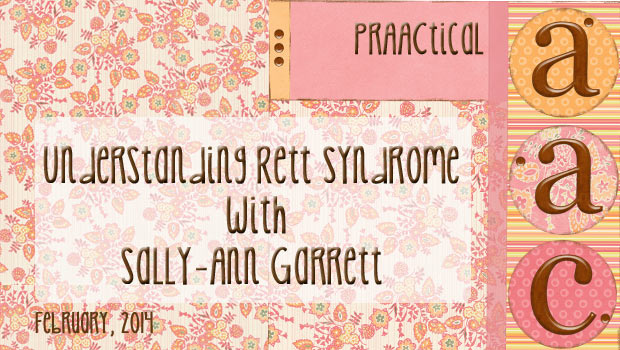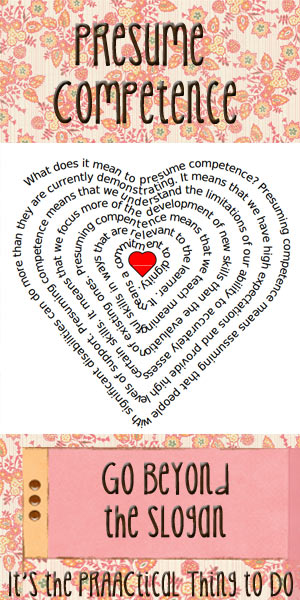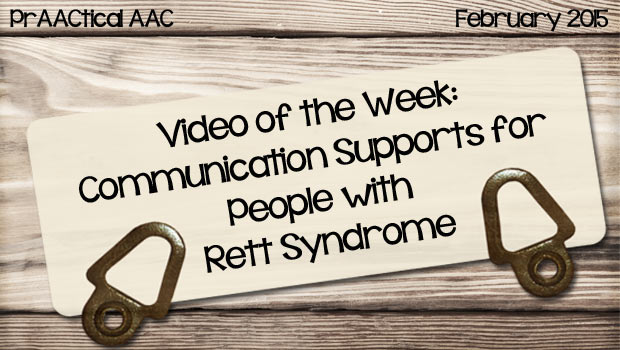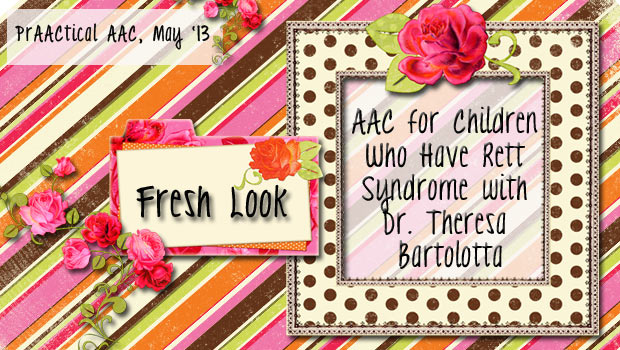Understanding Rett Syndrome by Sally-Ann Garrett

When we did our graduate training, there was little or no mention of Rett Syndrome, a genetic disorder involving a mutation of the MECP2 (Methyl CpG Binding Protein 2) gene on the long arm of the X chromosome. It is a complex disorder and the abilities of those who are affected by it are generally masked by the motor challenges that are a part of Rett. We’ve asked some professionals  experienced in Rett and AAC to help us use this space to help us gain a better understanding of the disorder and its implications for AAC intervention. Sally-Ann Garrett (Highly Specialist Speech and Language Therapist; Reg. HCPC; MRCSLPT, Reg. ASLTIP) is one who agreed to do so and we are grateful for her perspective. Sally-Ann is semi-retired now but has worked with girls affected by Rett Syndrome for 30 of her 42 years as an SLT. She lived in Canada for a number of years and while working in Ontario, she held a post as an adjunct lecturer at Queen’s University in Kingston. With colleagues at Queen’s University, she carried out an epidemiological study to find out how many more people in Ontario might have Rett Syndrome. That study was the basis for an Ontario registry. “I was able to help the families we located to develop simple communication strategies for their daughters. I’ve always believed that the girls understand far more than they are given credit for, and have searched for ways to prove that. I did not agree with so much of the research that had been done, which described the girls as profoundly impaired, especially as the researchers had not taken the severe apraxia into account in their methodology.” Sally-Ann maintains a private practice. is active in several Rett Syndrome organizations and administers two Facebook Groups about Rett Syndrome.
experienced in Rett and AAC to help us use this space to help us gain a better understanding of the disorder and its implications for AAC intervention. Sally-Ann Garrett (Highly Specialist Speech and Language Therapist; Reg. HCPC; MRCSLPT, Reg. ASLTIP) is one who agreed to do so and we are grateful for her perspective. Sally-Ann is semi-retired now but has worked with girls affected by Rett Syndrome for 30 of her 42 years as an SLT. She lived in Canada for a number of years and while working in Ontario, she held a post as an adjunct lecturer at Queen’s University in Kingston. With colleagues at Queen’s University, she carried out an epidemiological study to find out how many more people in Ontario might have Rett Syndrome. That study was the basis for an Ontario registry. “I was able to help the families we located to develop simple communication strategies for their daughters. I’ve always believed that the girls understand far more than they are given credit for, and have searched for ways to prove that. I did not agree with so much of the research that had been done, which described the girls as profoundly impaired, especially as the researchers had not taken the severe apraxia into account in their methodology.” Sally-Ann maintains a private practice. is active in several Rett Syndrome organizations and administers two Facebook Groups about Rett Syndrome.
Sally-Ann tells us:
“Over the years, I have found it interesting to set up light tech AAC to support people with a range of complex conditions, including those with Rett Syndrome. What interests me so much now, is that through eye gaze technology, we have a way to demonstrate what the girls or woman with Rett Syndrome might be thinking about, what she is interested in, and what she would like to tell us. It’s an exciting time, and I hope I can continue to contribute, to help give the girls and women the “voice” they need – many of the girls and women can’t talk, but they have so much to say!”
In this first post, Sally-Ann helps us to further understand the disorder and consider some of the issues relative to receptive communication.
Understanding Rett Syndrome
Rett syndrome, predominantly affecting females, is a pervasive developmental disorder with cognitive and neuro-motor impairments including a high degree of apraxia. The individuals (referred to in this article as “girls”) experience loss of hand skills and loss of communicative skills during the regression phase of the disorder, and are unable to effectively use switches and keyboards to access a computer.
Girls with Rett Syndrome face many challenges, the first being their limited hand skills. The neurotypical child learns about the world by handling different materials and toys; turning them over in her hands, finding them under a blanket, putting them inside boxes. In fact, most early learning is dependent on adequate play skills that facilitate the development of such cognitive skills. People who have Rett syndrome have not had such experiences because their functional hand use is poor; loss of purposive hand skills is a marker of the disorder, and I believe that the girls miss out on this important experiential learning.
The second challenge is the difficulty with motor planning – apraxia. The difficulty with motor planning in many research projects has been interpreted as evidence of delayed cognitive and linguistic development, and statements have been made that “the girls’ level of intentional communication is consistent with their level of cognition”. I believe it is more probable that the level of intentional communication and interaction that the girls can demonstrate is consistent with their level of motor development and disability, and is not indicative of their cognitive or internal thought and linguistic development.
To find out what a person understands, it is common practice to ask them to manipulate objects or toys to specific instructions, or to point to pictures to identify vocabulary items. (“Show me the car”, “Pick up the ball”, “Put the doll on the chair”.) These activities require that the individual being tested should have control of his or her motor responses, especially the hands. There are three reasons why this would be difficult for a person with Rett syndrome:
- As noted above, the girls experience severe apraxia: the inability to carry out purposive movement.
- Another feature is the pervasive hand stereotypy such as hand wringing, tapping, and mouthing .
- Changing muscle tone, and spasticity which increases with age will also cause difficulty with hand skills.
It is also possible to see delayed responses, either because of apraxia, or because of processing difficulties. All of these difficulties must be taken into account when planning intervention. Close observation often shows that the girls would look at the desired item, or when instructed, sometimes with a very fleeting glance which could be overlooked.
I believe that assessment using standardized testing is inappropriate unless modifications are made to the procedures to allow for increased processing time, or delayed reactions, or changes are  made to the materials and equipment to allow for alternative methods of indicating responses such as eye gaze. There is a growing body of evidence that girls with Rett Syndrome can use their eye gaze intentionally. Use of eye gaze technology appears to be a way of bypassing the severe apraxia/motor planning disorder, allowing the individuals to demonstrate otherwise hidden knowledge of vocabulary and concepts.
made to the materials and equipment to allow for alternative methods of indicating responses such as eye gaze. There is a growing body of evidence that girls with Rett Syndrome can use their eye gaze intentionally. Use of eye gaze technology appears to be a way of bypassing the severe apraxia/motor planning disorder, allowing the individuals to demonstrate otherwise hidden knowledge of vocabulary and concepts.
What Do Girls with Rett Understand?
Many people, (parents, caregivers and professionals) believe that the girls are “locked in”, and unable to demonstrate what they know and understand. This is important to acknowledge, even as a remote possibility, because what we believe about an individual affects the way we interact with them. If we think a person does not understand, we may not talk to that person at all. If we think a person is profoundly delayed in their development, we may talk to them as if they are a baby, or a child, irrespective of their chronological age. How will the individual then learn language, or learn about their world?
I believe that communication skills can be improved, first, by working with the caregivers (family members, paid carers) to identify the range of existing strategies which the girl or woman is using, and second, by providing simple opportunities for the girl or woman to communicate more effectively in her environments. A Speech and Language Therapist can assist the family or others become more aware of the special and often idiosyncratic communication skills exhibited by girls and women with Rett syndrome, so that these skills can be enhanced and used to their maximum benefit.
Intervention for improvement of communication and language skills should be planned through all the stages of the girl or woman’s life. We should meet her needs as she matures, grows and develops from a child to a teenager and to a woman, and provide her with appropriate vocabulary to reflect her chronological age and interests.
Intervention should address communication needs, receptive and productive language development through AAC. Intervention for improved speech production is probably not realistic. A lot of time could be spent on trying to help the girl to use speech, and this would take away from opportunities for improving communication.
Receptive language skills can be improved by continued language stimulation from others. It is very important to play with and talk to the girls about the activity. If she is unable to handle materials and toys independently, the adult should encourage the girl with Rett syndrome to touch, hold, and manipulate the world around her. This will help her develop concepts and receptive vocabulary.
Intervention for expressive language will include the use of augmentative or alternative communication (AAC) using a variety of access methods. As nearly all people with Rett syndrome are non-verbal, goals for AAC must be included in the treatment or intervention plan. If AAC is to be used, access to a specialist AAC Resource Centre might be considered. If special devices need to be purchased, some assistance with funding is available, but money is not easy to come by. However, there is a lot you can do without access to specialist services or expensive high tech equipment.
Aided approaches for AAC include the use of graphic displays or high tech devices. The display may be as simple as a collection of objects, or a page of photographs, or as complex as a portable computer or voice output communication device.
Unaided approaches are those that rely on gestural communication, using hands, fingers, face and body. Some girls with Rett syndrome are capable of using their bodies for gesture and body language, but limb and hand gestures are rarely used. Families are usually very good at reading body language, including understanding the mood of the girl, and how she is feeling.
:::::::::::::::::::::::::::::::::::::::::::::::::::::::::::::::::::::::::::::::::::::::::::::::::::::::::
Like many of you, we are eager to see how future developments in technology and therapeutic practices can be used to benefit people affected by Rett Syndrome. We’re looking forward to hearing more about how to address the AAC needs of people affected by this disorder in future posts. Do you have experiences providing AAC supports to children and adults with Rett Syndrome? We’d love to hear from you.
Filed under: PrAACtical Thinking
Tagged With: Rett syndrome, Sally-, Sally-Ann Garrett
This post was written by Carole Zangari



5 Comments
I am a speech language pathologist at the Vanderbilt Bill Wilkerson Center. A colleague and I are working collaboratively with a developmental psychologist to assist in setting up a Rett Syndrome Clinic here at Vanderbilt. We have been charged with putting together a battery of assessments for language to use during clinic days. Any input you have regarding which assessments you have had success in using and how you have modified those assessments to meet the needs of these girls would be greatly appreciated. Please feel free to resond via email at amanda.l.fortner@vanderbilt.edu. Thanks!
Thank you Amanda. This is an interesting point, about how to carry out valid assessment with girls and women with Rett syndrome, and one which I hope to we can discuss further. Hope to hear from you soon.
Hello, my daughter Emilee has Rett Syndrome. She communicates with a tobii eye gaze generating computer. She can write using an alternative eye gaze keyboard and word prediction. She has many page sets, she can access which screen she wants to use independently. With her newest Tobii she is now able to e-mail people that she desires. She must follow multiple steps to achieve this. Emilee was very motivated by the opportunity to e-mail. Although we see and believe in her abilities, we are still and always amazed by her progress. Locked away, for sure,but given the respect and opportunities she continues to unlock and blossom. Technology is the key!!!
Dear Shery, I am glad to hear about your daughter, so thank you for sharing. Eye gaze technology will open all kinds of possibilities, for assessment, education and learning and most of all for communication. It is thrilling to hear how your Emilee has progressed, and her story will give hope to many other parents. Technology should be in the future for the girls.
Hi Sally-Ann,
Our daughter Abby (3 1/2) has recently been diagnosed with Rett Syndrome. I am so encouraged by your perspective on the capabilities of girls with Retts, as we have always felt that Abby understands much more than she is able to communicate. The response in the comments from Shery Boyman certainly gives me a lot of hope – as we are only really starting out on our journey and have not yet had the opportunity to access eye gaze technology. However, from what I can see and read this technology may make the world of difference for Abby. Thank you.